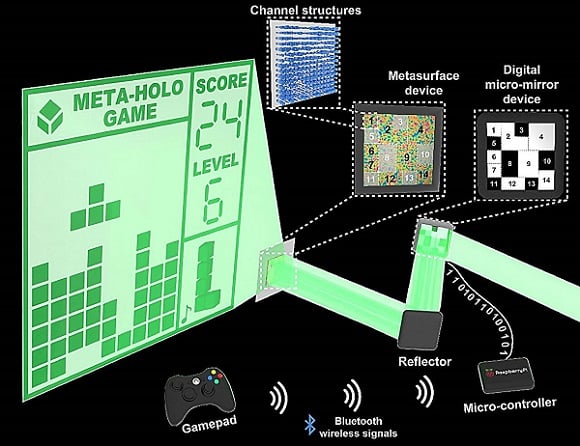Recently, metasurfaces have garnered research interest in holography due to their ability to introduce abrupt changes to fundamental wave properties like amplitude and phase through nanostructuring at subwavelength scales.

Even so, dynamic metasurface holography still faces challenges in realizing the real-time, highly fluidic dynamic display effects necessary for applications like human-computer interaction. Bottlenecks in computational and display frame rates have hindered progress.
To address these challenges, a team from the Wuhan National Laboratory for Optoelectronics at Huazhong University of Science and Technology has developed a technique which segments the display functionality of metasurfaces into distinct spatial regions or channels, with each capable of projecting a reconstructed sub-holographic pattern. The method, described as a dynamic interactive bitwise metasurface holography (Bit-MH) technique, achieves high computational and display frame rates, making it practical as an interactive metasurface holographic display system.
Utilizing optical addressing for spatial channel multiplexing, the team mapped the on/off states of all channels to a set of bit values, thus transforming the dynamic updating process of holography into the manipulation of these bit values to control the corresponding channels.The approach significantly enhances computational efficiency by using mapped bitwise operations rather than relying on rapid Fourier transform calculations required by traditional dynamic holography updates, resulting in efficient dynamic refreshing.
The researchers performed benchmark tests of the core algorithm for bitwise dynamic holography on a low-power Raspberry Pi computing platform, revealing that the maximum computational frame rate of the bitwise dynamic holography approach can reach up to 800 kHz. Additionally, by employing high-speed DMD optical addressing devices, they achieved a maximum display frame rate of 23 kHz.
To demonstrate the concept, the research team built an interactive holographic gaming system for playing Tetris within the visible light spectrum. The system's core components include a spatially segmented metasurface device, DMD, Raspberry Pi controller, gaming controller, and necessary optical components.
The proposed design for bitwise dynamic holography allows for efficient updating of holographic images and real-time interaction with external input devices. This efficient and programmable Bit-MH method is expected to pave the way for future smooth and efficient metasurface holographic display systems.
The research was published in Opto-Electronic Advances (www.doi.org/10.29026/oea.2024.230108).




